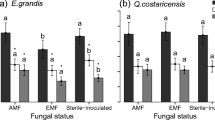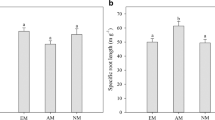Abstract
We investigated the impact of arbuscular mycorrhizae fungi on common cattails (Typha latifolia), a ubiquitous wetland plant species. The mycorrhizal relationship, which involves the exchange of fungal-acquired nutrients and plant-produced carbon, has been shown to elicit a range of physiological and biochemical responses in host plants. Growth, photosynthetic activity, biomass accumulation, and nutrition were compared between seedlings inoculated with viable mycorrhizal fungal spores and control seedlings given a sterilized inoculum. Plants were grown in inundated soils at three levels of phosphorous availability under glasshouse conditions for 11 weeks. The presence of arbuscules and hyphae was confirmed in all inoculated plants with levels of infection reaching 23.1 and 34.1%, respectively. Control plants were taller and had greater above- and below-ground biomass. Photosynthetic rates measured at week 11 of the experiment were significantly higher in mycorrhizal plants than in control plants. Mycorrhizal plants had higher concentrations of N, P, and C in their shoots and higher concentrations of N in their roots. Our results suggest that under greenhouse conditions, the fungus acts to reduce host plant growth despite increased mineral nutrition and photosynthetic activity.
Similar content being viewed by others
Literature cited
Bethlenfalvay, G. J., R. S. Pacovsky, and M. S. Brown. 1982. Parasitic and mutualistic associations between a mycorrhizal fungus and soybean: development of the host plant. Phytopathology 72:889–893.
Blackwell, M. 2000. Terrestrial life—fungal from the start? Science 289:1884–1885.
Bronstein, J. L. 2001. The exploitation of mutualisms. Ecology Letters 4:277–287.
Brundrett, M. C., Y. Piché, and R. L. Peterson. 1984. A new method for observing the morphology of vesicular arbuscular mycorrhizae. Canadian Journal of Botany 62:2128–2134.
Daft, M. J. and A. A. El-Giahmi. 1978. Effect of arbuscular mycorrhiza on plant growth. VIII. Effects of defoliation and light on selected hosts. New Phytologist 80:365–372.
Douds, D. D., Jr., C. R. Johnson, and K. E. Koch. 1988. Carbon cost of the fungal symbiont relative to net leaf P accumulation in a split-root VA mycorrhizal symbiosis. Plant Physiology 86:491–496.
Fitter, A. H. 1991. Costs and benefits of mycorrhizas: implications for functioning under natural conditions. Experientia 47:350–355.
Fitter, A. H. and R. Hay. 2002. Environmental Physiology of Plants, third edition. Academic Press, Inc., San Diego, CA, USA.
Graham, J. H. and D. M. Eissenstat. 1994. Host genotype and the formation and function of VA mycorrhizae. Plant and Soil 159:179–185.
Harley, J. L. 1989. The significance of Mycorrhiza. Mycological Research 92:129–139.
Harris, D. and E. A. Paul. 1987. Carbon requirements of vesicular-arbuscular mycorrhizae. P. 95–103. In G. R. Safir (ed.) Ecophysiology of VA Mycorrhizae. CRC Press, Boca Raton, FL, USA.
Hayman, D. S. 1974. Plant growth response to vesiclar arbuscular mycorrhiza. VI. Effect of light and temperature. New Phytologist 73:71–80.
Jakobsen, I. and L. Rosendahl. 1990. Carbon flow into soil and external hyphae from roots of mycorrhizal cucumber plants. New Phytologist 115:77–83.
Johnson, N. C., J. H. Graham, and F. A. Smith. 1997. Functioning of mycorrhizal associations along the mutualism-parasitism continuum. New Phytologist 135:575–585.
Koide, R. 1985. The nature of growth depression in sunflower caused by vesicular-arbuscular mycorrhizal infection. New Phytologist 99:449–462.
Lovelock, C. E., D. Kyllo, M. Popp, H. Isopp, A. Virbo, and K. Winter. 1997. Symbiotic vesicular-arbuscular mycorrhizae influence maximum rates of photosynthesis in tropical tree seedlings grown under elevated CO2. Australian Journal of Plant Physiology 24:185–194.
Marschner, H. and B. Dell. 1993. Nutrient uptake in mycorrhizal symbiosis. Plant and Soil 159:89–102.
McGonigle, T. P., M. H. Miller, D. G. Evans, G. L. Fairchild, and J. A. Swan. 1990. A new method which gives an objective measure of colonization of roots by vesicular-arbuscular mycorrhizal fungi. New Phytologist 115:495–501.
Miller, P. M. and J. D. Bever. 1999. Distribuiton of arbuscular mycorrhizal fungi in stands of the wetland grassPanicum hemitomon along a wide hydrologic gradient. Oecologia 119:586–592.
Miller, R. M., C. I. Smith, J. D. Jastrow, and J. D. Bever. 1999. Mycorrhizal status of the genusCarex (Cyperaceae). American Journal of Botany 86:547–553.
Miller, S. P. and R. R. Sharitz. 2000. Manipulation of flooding and arbuscular mycorrhiza formation influences growth and nutrition of two semiaquatic grasses. Functional Ecology 14:738–748.
Peat, H. J. and A. H. Fitter. 1993. The distribution of arbuscular mycorrhizas in the British flora. New Phytologist 125:845–854.
Peng, S., D. M. Eissentat, J. H. Graham, K. Williams, and N. C. Hodge. 1993. Growth depression in mycorrhizal citrus at high-phosphorus supply. Plant Physiology 101:1063–1071.
Rickerl, D. H., F. O. Sancho, and S. Ananth. 1994. Vesicular-arbuscular endomycorrhizal colonization of wetland plants. Journal of Environmental Quality 23:913–916.
Selelosse, M-A. and F. Le Tacon. 1998. The land flora: a phototroph-fungus partnership? Trends in Ecology and Evolution 13:15–20.
Smith, S. E. and D. J. Read. 1997. Mycorrhizal Symbiosis, second edition. Academic Press, Inc. San Diego, CA, USA.
Son, C. L. and S. E. Smith. 1988. Mycorrhizal growth responses: interactions between photon irradiance and phosphorus nutrition. New Phytologist 108:305–314.
Stenlund, D. L. and I. D. Charvat. 1994. Vesicular arbuscular mycorrhizae in floating wetland mat communities dominated by Typha. Mycorrhiza 4:131–137.
Stevens, K. J. and R. L. Peterson. 1996. The effect of a water gradient on the vesicular-arbuscular mycorrhizal status ofLythrum salicaria L. (purple loosestrife). Mycorrhiza 6:99–104.
Stutz, J. C. and J. B. Morton. 1996. Successive pot cultures reveal high species richness of arbuscular endomycorrhizal fungi in arid ecosystems. Canadian Journal of Botany 74:1883–1889.
Taiz, L. and E. Zeiger. 2002. Plant Physiology, third edition. Sinauer Associates, Inc., Publishers. Sunderland, MA, USA.
Tennant, D. 1975. A test of modified line intersect method of estimating root length. Journal of Ecology 63:995–1001.
Turner, S. D., J. P. Amon, R. M. Schneble, and C. F. Friese. 2000. Mycorrhizal fungi associated with plants in ground water fed wetlands. Wetlands 20:200–204.
Wetzel, P. R. and A. G. van der Valk. 1996. Vesicular-arbuscular mycorrhizae in prairie pothole wetland vegetation of Iowa and North Dakota. Canadian Journal of Botany 74:883–890.
Wright, D. P., D. J. Read, and J. D. Scholes. 1998a. Mycorrhizal sink strength influences whole plant carbon balance ofTrifolium repens L. Plant, Cell and the Environment 21:881–891.
Wright, D. P., J. D. Scholes, and D. J. Read. 1998b. Effects of VA mycorrhizal colonization on the photosynthesis and biomass production ofTrifolium repens L. Plant, Cell and the Environment 21:209–216.
Author information
Authors and Affiliations
Rights and permissions
About this article
Cite this article
Dunham, R.M., Ray, A.M. & Inouye, R.S. Growth, physiology, and chemistry of mycorrhizal and nonmycorrhizalTypha latifolia seedlings. Wetlands 23, 890–896 (2003). https://doi.org/10.1672/0277-5212(2003)023[0890:GPACOM]2.0.CO;2
Received:
Revised:
Accepted:
Issue Date:
DOI: https://doi.org/10.1672/0277-5212(2003)023[0890:GPACOM]2.0.CO;2




